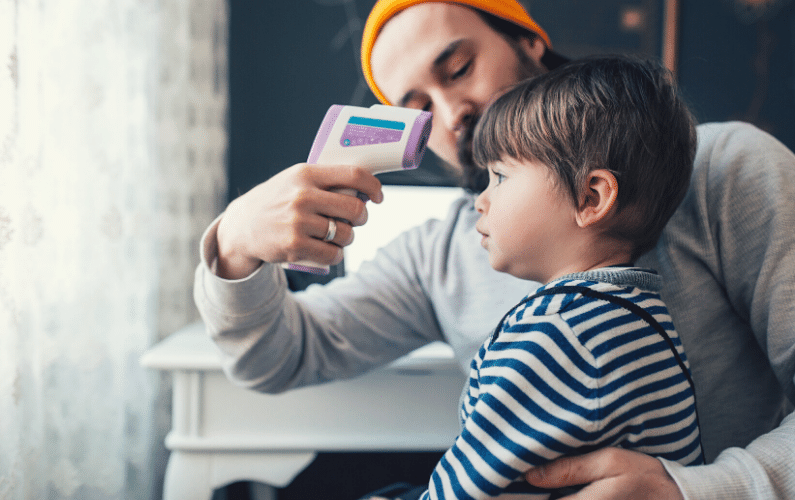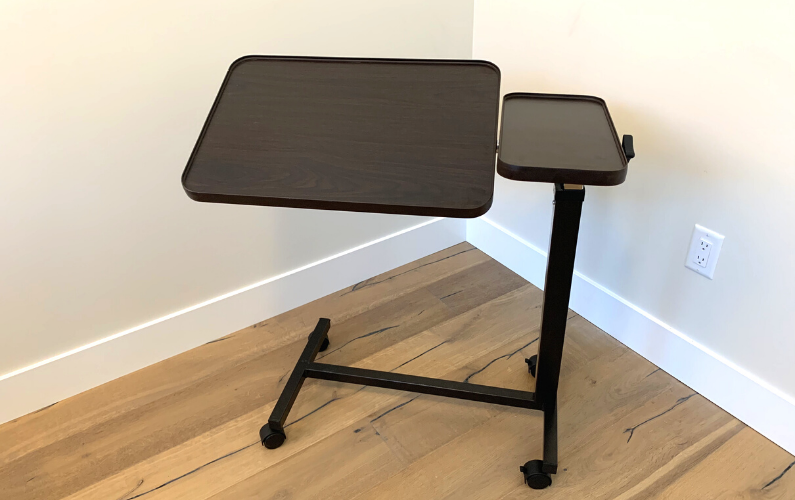Learn about how to use infrared thermometers in homes, schools, and child care centers.
Are Infrared Thermometers Safe for Children and Babies?
One of the common conditions parents and caregivers cope with is an elevated body temperature. These temperatures can come on unexpectedly. Given the convenience and speed of infrared thermometers, they are being used more and more in homes, schools, and child care centers. This leaves parents wondering – are they safe? However, rumours are popping up warning about the potential dangers of infrared thermometers. The good news is that the risks posed by these thermometers are being proved wrong. Here's what you need to know.
What is a Non-Contact Infrared thermometer?
To help explain why they are safe, we first need to explore what they are. Non-Contact thermometers are also known as infrared (IR) thermometers measure the heat coming from a person (surface temperature) from a distance. Infrared thermometers are receivers - they do not emit radiation to the body. It is a common misconception that some sort of rays are being emitted into the body to measure temperature. This is particularly concerning for parents of young children. Tim Robinson, VP of Marketing of Thermoworks, said it best in his baseball metaphor "There's a sensation that you're somehow sending something that's going to bounce back, but none of that is true" he went on to say "it's just a catcher. It's catching light waves.".
The two main types of non-Contact infrared thermometers for kids are forehead thermometers and in-ear non-contact infrared thermometers. Ear thermometers are called tympanic thermometers and measure the child's ear by reading infrared heat emitting from the eardrum. These are for children 6 months old and older. It is important to know that they are inaccurate in infants whose ear canals are too narrow for a proper heat reading.
Benefits of Non-Contact Infrared Thermometers for Children
It's commonly known that children often spread viruses. Summer comes to an end, kids are back at school, and voila one kid in the household is sick. Likely followed by other members of the family. Reducing shared touchpoints is very important in slowing the spread of germs, which is one reason non-contact infrared thermometers are useful. Other benefits include:
- Reduce the risk of spreading disease
- Quick Readings
- Easy to read digital display
- Quick to take follow-up temperatures for averaging
- Easy to clean and disinfect
- Non-invasive
- Unlikely to agitate a child who is not feeling well
In a setting such as a daycare or a school, the non-contact forehead thermometer allows for very fast and efficient screening of a large number of kids.

Downsides to Non-Contact Infrared Thermometers
Nothing is perfect, here are some downsides to the non-contact infrared thermometers:
- Readings on infrared thermometers are sensitive and results can vary. It is recommended to take the temperature 2 to 3 times.
- On average, infrared thermometers are certainly more expensive than traditional thermometers. They generally range from $50 to $200, depending on brand and features.
- External environment changes can affect the reading - for example, if it is too hot or too cold. They can also be affected by humidity.
To get an accurate reading, ensure that you have direct access to the child's bare forehead. Make sure that hats and headbands are not in the way. If your child has been outside in the cold, bring them inside and warm them up before taking their temperature, then retake the temperature in several successive five-minute intervals until you are comfortable that you have the correct reading.
Thermometer Safety Reminder
Before we get into the proper use of an infrared thermometer we have an important safety message. If you are researching thermometers, you are likely looking for an upgrade. Please do not use a mercury thermometer, you can read more about the evolution of the mercury thermometer to the infrared thermometer in our blog post:Infrared Thermometers - a Major Step Forward in Home Healthcare. Most mercury thermometers in households now are old and potentially unsafe.

Know-How to Use Your Infrared Thermometer
Each Infrared thermometer will come with instructions for use. However; some important general guidelines for use are:
- Use in an area free of drafts
- Do not use in direct sunlight
- Ensure you read instructions for appropriate distance from the forehead
- Keep the sensor area clean and dray
- Do not touch the sensor area of the thermometer
- Do not use in high or low temperatures - generally 16 to 40 Celsius (60 to 104 Fahrenheit)
- Ensure thermometer is in proper working order - take someone's temperature that is not ill, ensuring it reads approximately 36.4 to 37.2 Celsius (97.5 to 98.9 Fahrenheit)
Talk with your doctor or pediatrician if you have any questions about the best method of taking your child's temperature, how to treat a fever, and when to seek medical treatment.
Infrared thermometers are generally very reliable and easy to use. If you are looking for a reliable, low-cost model our HaloHealthcare.com recommendation is the Dikang Infrared Thermometer. We chose this model for its reliability and affordable price. Other popular models are Dr. Ho's Infrared Touchless Thermometer and Homedics No Touch Infrared Thermometer. All of these models qualify for free shipping.
Check out the AMG PhysioLogic Pro Scan Non-Contact Thermometer below.
We hope you gained some insight into infrared thermometers and the benefits of using them when taking the temperature of children and babies. If you want to see all of the infrared thermometers we offer, click here!










